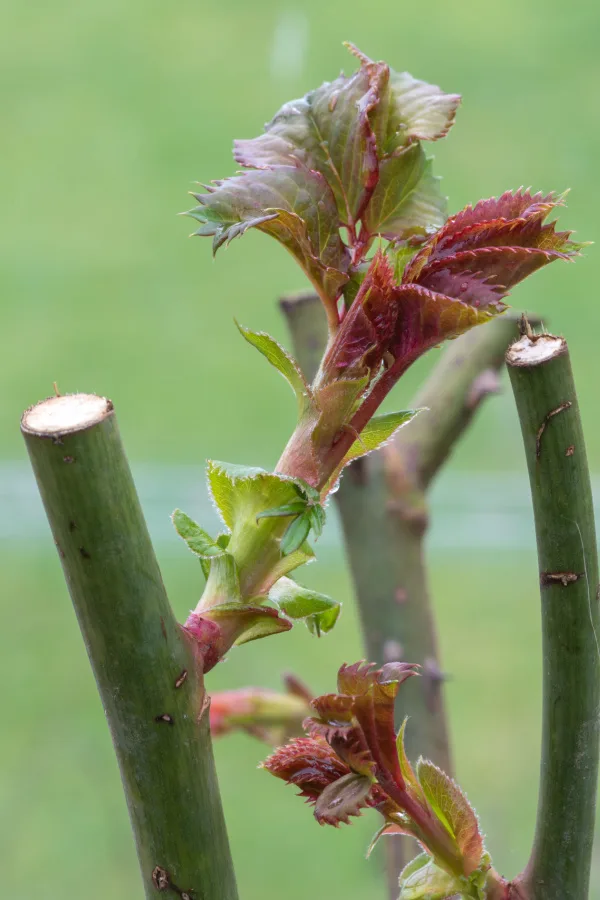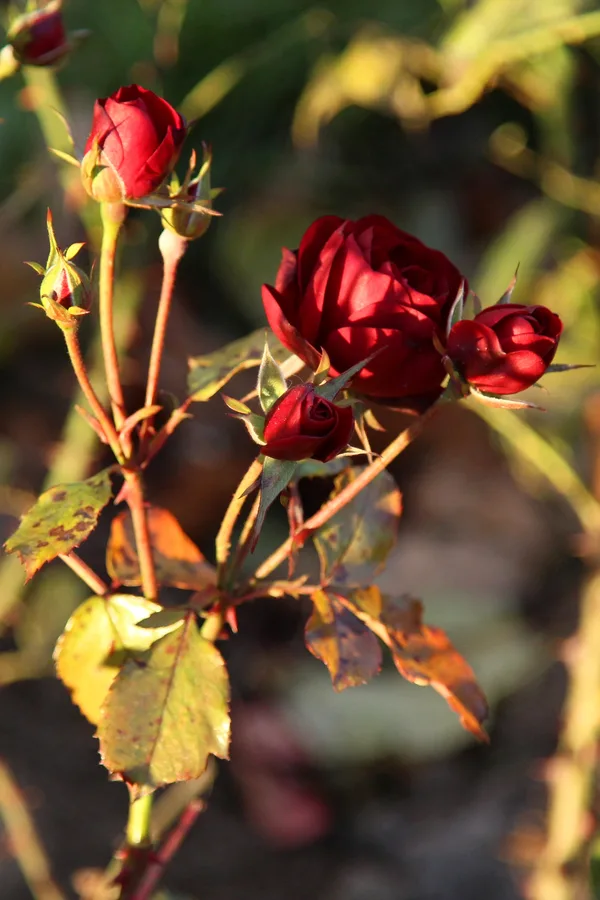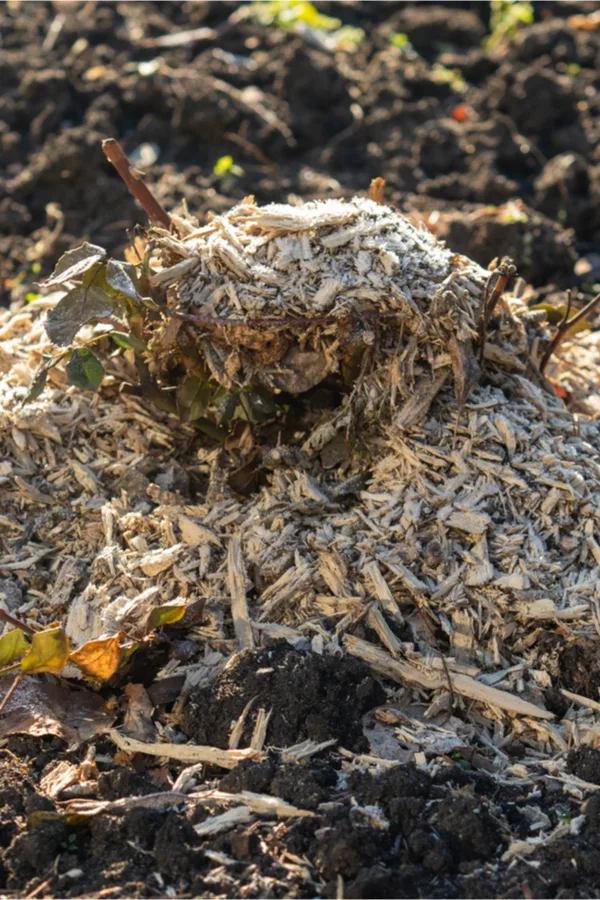Looking for a few fall care tips, tricks and secrets for how to best prepare your rose bushes for the upcoming winter?
One thing is for sure – fall is an extremely important time for all varieties of roses. Whether it be hybrid tea roses, floribunda, climbing, or even shrub roses – not only will how you care for your roses this fall play a pivotal role in how well they grow and bloom next summer, it can also mean the difference between life and death for the plants before spring ever arrives!
Unfortunately, harsh winter weather can be deadly for rose bushes. Especially ones that are left unprotected or weakened by improper fall care. Not just in areas that might see extreme cold, snow and ice through the winter months, but also in climates that have excessive rain, wind or drought.

How To Prepare Rose Bushes For Winter
Fall rose care often causes quite a lot of confusion and questions among gardeners. Do I need to prune my roses back in the fall? Should I be fertilizing before winter or do I wait until spring? And how and when should I mulch my roses before winter – and what should I be mulching with?
It’s certainly easy to see with all of those questions above how knowing just what to do can seem a bit daunting. But here is the good news – providing great fall care for your roses doesn’t have to be complicated. Nor does it have to be labor intensive or time consuming.
Success really comes down to performing a few simple chores – and at the same time – avoiding a couple of the most common mistakes gardeners make that put their roses in jeopardy of winter survival. And the first of those common mistakes centers around fall pruning!
To Prune Or Not To Prune – How To Prepare Rose Bushes For Winter
If there is one critical mistake gardeners make more than others that puts their roses in danger of winter survival – it’s pruning their roses in the fall. Fall is not the time for any type of serious rose pruning action. In fact, unless there is a damaged or broken limb, no stems or branches should be removed from your roses.

Pruning is a signal for plants to regenerate and sprout new growth. Even deadheading spent blooms in late fall will spur new activity. When this happens in late summer or early autumn, it can spell disaster for plants as they head into the long, cold winter.
Any new late season growth puts a rose bush at risk for damage. The tender new shoots and stems take power from the plant as they grow. Then, when the hard frosts and freezes begin, not only is the new growth killed off, but the entire bush is vulnerable to freezing out.
Instead, always wait to prune until late winter or just before spring. This allows for the rose bush to be completely dormant. At this point, the rose bush will not attempt to generate any new foliage or growth until the warmth of spring is in the air, making it safe to prune back.
Fertilizing – How To Prepare Rose Bushes For Winter
Much like pruning, fertilizing is a big no-no in the fall. Fertilizing of roses should only occur in the early spring and summer months. Once late summer and early fall have arrived, fertilizing will cause far more damage than good.
Just as with pruning, fertilizing will force rose bushes into tender, late season growth. And this fragile growth can be both above ground and within the rose bushes root structure. If the winter is then severe enough, all of that new, tender growth is highly susceptible to freezing and thawing. Not just putting the new growth at risk – but the entire rose bush.
Protecting Roses From Rain, Cold, Snow & Ice – How To Prepare Rose Bushes For Winter
When it comes to providing protection for your roses from the constant thawing and freezing winter can bring, the type of protection will depend on the type of rose bush you are growing.

In general, depending on the variety and your location, the more severe your winter, the more you will need to help protect your roses. With those two factors in mind, here is a look at how to protect each of the common rose bush styles:
Hybrid & Tea Roses – How To Prepare Rose Bushes For Winter
Hybrid and tea roses are among the most popular of rose bushes. They also happen to require the most protection among all rose bush types, especially for those that grow in colder climates.
Once mid-autumn has settled in, rake back any leaves that have fallen and gathered around the base of the rose bush. Allowing the leaves to remain is asking for trouble. Unfortunately, rose leaves can harbor both insects and disease, so getting them out of the way is a must.
Once the base area has been cleared, apply a heavy six inch layer of sawdust around the limbs at the base of the rose bush. When it comes to hybrid and tea roses, the base is where the grafts or stem unions are located.
By covering these, you protect the most susceptible part of the rose bush from dying out. If you cannot find access to sawdust, use compost. Compost helps to insulate and provide nutrients, and is a great choice for protecting roses. (See: How To Make Great Compost In The Fall)

Climbing Roses – How To Get Rose Bushes Ready For Winter
Climbing roses tend to have more issues with wintertime damage from wind than cold. Although their roots are usually fairly well established, their tall canes can be whipped by the wind. They can also sustain damage from heavy loads of snow and ice.
If your climbing roses are attached to a pergola or trellis, tie them off securely to the structure. This will keep any strong winter weather from breaking them off or injuring the canes.
If they are not clinging to any structure, the process is a bit different. Unfortunately, simply tying them up will not provide enough support or protection. Instead, gather the canes together, and using a rope, tie them together.
After you tie the canes together, lay the bundle down on the ground and cover the canes with six inches of straw, sawdust or compost. This will keep the canes strong from any damaging winter weather.
Protecting Shrub Roses – How To Get Rose Bushes Ready For Winter
When it comes to fall rose care, shrub roses are by far the easiest variety to prepare for winter. With a strong root structure, shrub roses tend to be extremely tolerant of cold weather. As long as you don’t live in an area with severe winter weather, shrub roses require little care to survive.

To prepare shrub roses for winter, rake away any leaves around the base that have fallen from the rose. Much like with the other varieties, rose leaves just have too much potential to carry disease and hide pests.
Once the plant has fallen into dormancy, apply a three to four inch layer of compost around the base of the plant. This will help protect the base from constant freezing and thawing, and provide nutrients as it decomposes into next spring.
Here is to giving the right kind of fall rose care this year to prepare your roses for winter – and to having them bloom bigger and stronger than ever next year!
Follow Our Facebook Page For Great Gardening Tips And Advice! This Is My Garden Facebook Page
This Is My Garden is a garden website created by gardeners, for gardeners. Jim and Mary Competti have been writing gardening, DIY and recipe articles and books and speaking for over 15 years from their 46 acre Ohio farm. They publish three articles every week, 52 weeks a year. Sign up today to follow via email, or follow along!
